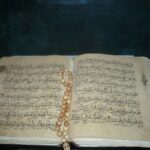By Mikhaylo Yakubovych
Despite early attempts to publish the Holy Quran (1534, Venice, and later European editions), a long period needed for the Muslim book’s printing to publish the Quran.
In fact, it did not happen until the nineteenth century. It is known that for the first time Quran published in mass print in the Russian Empire (Saint-Perterburg, 1787) and since 1802 began to be published in Kazan, Tatarstan. This edition, known as the “Kazan Quran”, was prepared for printing by Muslim calligraphers and became so popular that it began to displace the manuscript tradition of rewriting the Quran.
Almost every few years, these editions were reprinted, acquired new forms and contents (from the smallest to the largest, from partial to complete) and were published almost until the First World War (f.e. the circulation of 1901 was quite large). Given that both the Crimea and the regions of the Great Duchy of Lithuania where the Tatars lived, were the parts of the Russian Empire, it was there Quran most in demand. Many copies are still stored in the families of the Tatars of the Grand Duchy of Lithuania.
In the Historical and Cultural Reserve of Ostroh city there is a “Kazan” Quran of 1901 edition, which contains not only various recommendations (for example, when and which suras to read), but also calendar-type notes kept by a family from Pluzhny (Izyaslav district, Khmelnytsky region) up to the 1950s: in particular, the dates of the holiday “Eid al-Adha”. For many, these Qur’ans have been and remain a family heirloom. During the times of the Russian Empire, they could be ordered by mail in the same way as other editions from Kazan (fragments of the prayer book are preserved in the Ostroh Quran from the village of Kryliv in 1798).
Donbass is another destination, where many Tatars moved from the modern Volga region and lived there since the end of the 19th century. In their families, many mushafs of the “Kazan” press are still preserved. Some of the materials, especially instructions on ritual practice (duas, etc.) are stored in the Lviv Museum of the History of Religion. The “Kazan Quran” was also popular among Muslim diasporas in Ukraine, such as Azerbaijanis.
However, despite the significant influence on the religious tradition, the “Kazan” Qurans did not satisfy the Crimean Tatar environment, which was associated with the religious revival of the late nineteenth century.
Through the efforts of Ismail Gaspirali (Gasprinsky), the Bakhchisaray Quran was first published in 1893, a special edition made in the Crimea at the “Terjiman” printing house (Kalyam Kadim, Ancient Word, Kalyam Sharif, The Noble Word).

According to the Ukrainian researcher Amin al-Qassem, the basis of the Bakhchisaray Quran was not the “Kazan” edition, but the manuscript of the calligrapher from Istanbul Muhammad – Nazif Kadyrgala. Every year some changes and clarifications were made to the edition (especially after 1909), and the last copies were published in 1914.
Ismail Gasprinsky made great efforts to make a financial profit from this project, constantly advertising the publication in the newspaper “Terjiman”, and achieved good success, including through the sale of most of the circulation in the Ottoman Empire, Egypt and other countries. Popular was not only the “standard” edition (10 x 6, 522 pages, 15 lines on each, without ayaats numbering, but with page numbering, handwriting naskh with a slight slope; pause signs, typical of the Ottoman tradition), but also larger and smaller its copy. Dozens of “Bakhchisaray” Qurans have survived up to the present day. One of the most popular was the 1898 edition.
The popularity of this publication was facilitated by the fact that it belonged to lithographic, and lithography as technology was actually based on manuscripts, ie on the reproduction of the prototype manuscript. This caused less religious prejudice than just typed text (however, in the early twentieth-century technologies allowed to publish the text without errors such as “rebounds” of diacritical marks, etc.).
The hardcover of the publication was kept for a long time. The success of the publication was facilitated by the inscription that it was “considered” by “two sheiks of Islam” (in Istanbul and Cairo); such an inscription is contained, in particular, in the last edition (1331 / 1913–1914, large edition 30 x 20 cm). Thus, the Muskhafs published by Ismail Gasprinsky became not only the first published in the Crimea and the region in general, but also a significant contribution to the development of Muslim book’s printing and to its mass popularization.
In this case, the Crimean intellectual tradition of the time (especially Ismail Gasprinsky personally as a representative of Jadidism – the movement for Islamic reform) revealed its identity, maintaining ties with the Ottoman Empire and other parts of the Muslim world. It has been achieved despite significant pressure from imperial forces.
Moreover, Gasprinsky’s considerable efforts to reprint the Qur’an as a primary source generally fit into the Islamic tradition of the Enlightenment as a “return to the origins” rather than the creation of new constructions. As a significant historical artifact, Gasprinsky’s edition deserves at least a reprint today.





